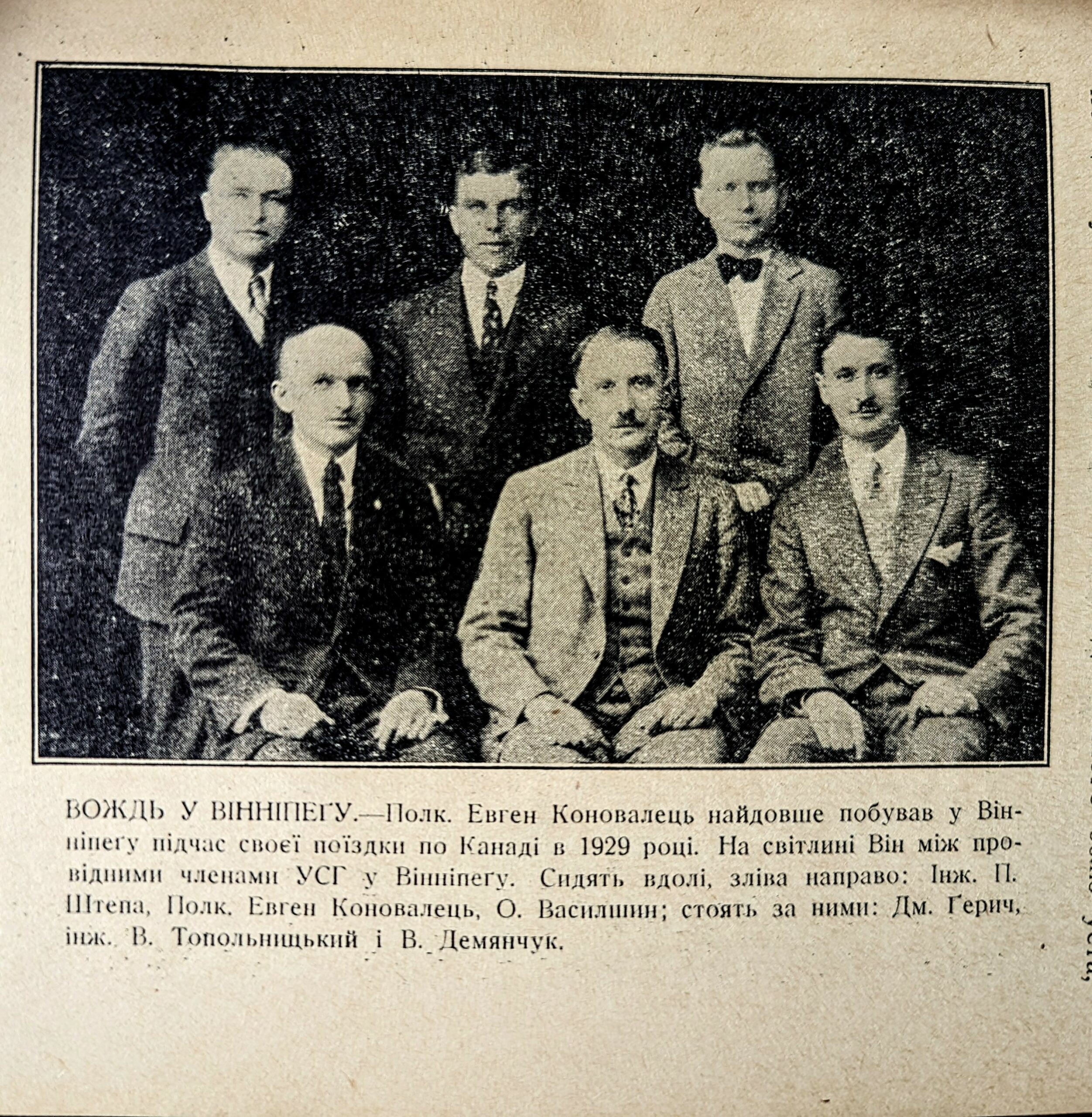Lev Pavlenko
Rare Books and Archives Committee UNF Toronto, Kyiv
In modern Ukraine’s history, Ukrainian Sich Riflemen (Ukrainski Sichovi Striltsi, or the USS) and later, the Sich Riflemen, are two military units strongly associated with the fight for Ukrainian independence in the period between 1914 and 1921. The Ukrainian Sich Riflemen was established in 1914 as a Ukrainian corps in the Austro-Hungarian army. In 1917, after the revolution in Russian Empire had begun, a large portion of the USS, who were prisoners-of-war in Russia, escaped the POW camps and formed a core of a separate fighting force called the Sich Riflemen. Unlike the Austro-Hungarian USS, this new corps was loyal to the emerging Ukrainian government – Ukrainian Central Council, which later transformed into the Ukrainian People’s Republic. The Sich Riflemen was one of the most distinguished and capable formations of the armed forces of the Ukrainian People’s Republic, which existed from 1917 to 1921. However, what happened to its members after the end of the Ukrainian War of Independence (also known as the Ukrainian Revolution and the Liberation Struggle) in 1921? Did they vanish in the riptide of the interwar years, or dissolve in the rest of the Ukrainian emigrants who would rather live in a foreign land than under Polish or Soviet rule? This article researches the legacy of the Sich Riflemen and other veterans of the Ukrainian Liberation Struggle who lived in Canada, with a focus on the interwar period (1921-1939).
The article will concentrate on two aspects: one is socio-political, and the other is academic. The sociopolitical aspect relates to the creation and participation in Ukrainian organizations such as the Ukrainian War Veteran Association of Canada (UWVA), the Ukrainian National Federation of Canada (UNF), and their connections with the Ukrainian Military Organization (UMO), and the Organization of Ukrainian Nationalists (OUN). The academic aspect of the Ukrainian veterans in the Canadian diaspora lies in the writing and publishing numerous books, articles, and memoirs regarding their participation in the First World War and the Ukrainian Revolution.
This study is based predominantly on the analysis of the giant historical and academic heritage of the Ukrainian community in Canada, such as the Rare Books and Archives Collection at the Ukrainian National Federation of Canada, Toronto Branch. This collection holds many primary sources of that period, including many memoirs of Liberation Struggle veterans, archives of the UWVA and UNF, as well as secondary sources – analytical and jubilee books, published by the veterans and their researchers. The materials in this collection proves that the veterans who relocated to Canada became key players in the continued fight for Ukrainian sovereignty – through developing large and powerful organizations, maintaining contact with other organizations actively involved in establishing Ukraine’s freedom, and through numerous books and publications. Also, as a part of this study, an interview was conducted with the secretary of the UWVA, George Serhijczuk.
The military path of the Ukrainian People’s Republic army ended after its internment by the Polish army at the end of 1920 and finally ended after the unsuccessful completion of the Second Winter Campaign in November 1921. After that, the fight for Ukraine’s independence had transformed into an underground revolutionary format, and was coordinated and financed mostly by Ukrainian emigrants. Those who decided to stay in Ukraine and wanted to continue their struggle had to do so undercover as a part of the Ukrainian Military Organization. However, many veterans and politicians of the Ukrainian People’s Republic and the West Ukrainian People’s Republic went to Europe or North America. Many chose Canada, since by the 1920s it already had a significant Ukrainian community which allowed the newcoming veterans to organize their activity on the foundation of “Prosvita” (international Ukrainian educative society) branches and “peoples houses” (narodni domy, community centres).
In January 1928, the Ukrainian War Veteran Association of Canada (UWVA) was created in Winnipeg, MB (Figure 1). The founding principles of the organization were the support of the idea of a free Ukraine, aid to the Ukrainian cause, and assistance to fellow veterans. In practical terms, the UWVA connected veterans, preserved and maintained the memory of the Ukrainian War of Independence, and raised money for Ukrainian schools, public education, and veterans in need (specifically, disabled veterans in Ukraine). The significant financial contribution of the UWVA in the latter aspect is documented by a certificate (hramota), issued by the Ukrainian Society of Aid to the Disabled in Lviv to the UWVA Toronto branch, as a sign of the “significant gift towards the disabled of the Ukrainian Army” (Figure 2).
The UWVA activity also lay in the practical aspect of regaining Ukrainian independence. For instance, in the UWVA archives there are mentions of its correspondence with the Ukrainian Military Organization, and with its head, the former commander of the Sich Riflemen, Col. Yevhen Konovalets. It is also documented that Col. Konovalets met with the UWVA chief officials during his trip to the USA and Canada in June 1929. This trip was taken shortly after the creation of the Organization of Ukrainian Nationalists in early February of 1929 and the unanimous election of Col. Konovalets as its leader. The visit itself was documented in the OUN archives, memoirs of the witnesses, and in the picture of Konovalets and the UWVA members, taken in Winnipeg, where the organization’s headquarters was located. During the visit, as suggested by the remained correspondence, they discussed the issues of growth and activity of the UWVA, fundraising, OUN activity, and the general support of the Ukrainian cause. According to the UWVA researcher Petro Mirchuk, the Association was very impressed by the visit of its leader, as he gave it ideological and spiritual unity.
In 1932, UWVA, together with several other organizations, merged into the Ukrainian National Federation of Canada (UNF). Although preserving a formal organizational autonomy, the UWVA became intertwined with the workings of the UNF, which became one of the biggest and most influential community organizations of the Ukrainian-Canadian diaspora. The close connection between the two organizations was aptly laid out in the report of the Chair of the UWVA Head Office M. Pohoretsky:
“The UNF developed from the UWVA, which built it on a non-partisan foundation. Without it, the UNF wouldn’t be able to exist but would break apart into small parties. The UWVA is the backbone of the UNF and must remain the same. Without the UWVA the UNF would be spineless, and without the UNF the UWVA truly would become [just] a small veteran’s club…”
This quote describes the interdependence and connection between the two organizations. The UWVA gave the ideological foundation for the existence of the Ukrainian National Federation through the principles of uniting Ukrainians on a non-partisan and non-confessional basis, awareness of their need to preserve their national identity, and the idea of a free Ukraine, which mirrored in the UNF’s principles.
Apart from the UWVA, which united veterans of the Ukrainian People’s Republic and the West Ukrainian People’s Republic (and later those Ukrainian-Canadians who served in the Canadian Army), there was a Brotherhood of the Ukrainian Sich Riflemen, that united veterans of the Austro-Hungarian Ukrainian Sich Riflemen corps exclusively. Its main activity was in maintaining the connection between the former corps members, regardless of their future affiliation or whereabouts. For example, the Brotherhood members lived not only in the USA and Canada but also in Germany and Argentina. Their activity also involved documenting the history of their military unit – publishing books with memoirs, articles, and photographs. These publications became an important part of the diaspora historical literature, that documented the history of Ukrainian freedom-fighting, and the formation of the national identity in the diaspora. For instance, in commemoration of the 40th anniversary of the corps’ establishment, the Brotherhood published a large book with countless memoirs, photographs, and maps of the Riflemen’s military record during the First World War and the ensuing Ukrainian War of Independence, as well as highlighting the legacy of the corps in the USA and Canada.
This mention gradually leads to the second important aspect of the Ukrainian veterans’ legacy – a significant volume of their historical and academic works. The importance of their documentary heritage is obvious – they are the first-hand accounts of people who lived and took part in the tumultuous period of 1914-1921, which makes them extremely valuable resources for historians. In emigration, they were able to publish their books, which could not be printed in occupied Ukraine. For instance, Ukrainian War-Historical Institute in Toronto published a whole series of materials on the history of the Ukrainian army in the Liberation Struggle, which consisted of at least eleven volumes, not including other numerous books and publications. In general, the amount of materials on the Ukrainian Revolution printed in Canada counts in dozens, if not in hundreds.
The veterans’ memoirs, reflections, and analysis, not to mention the maps and photographs constitute a priceless source of information regarding Eastern Europe in the years between 1914 and 1921. Their works pose interest for both academic researchers and the general audience, interested in history. Their heritage became the legacy of the Ukrainian-Canadian community, and the Ukrainian diaspora worldwide. The respect towards the Ukrainian veterans, their culture, and their songs is still alive in the Ukrainian community, becoming its integral cultural component.
After the First World War and the end of the Liberation Struggle in 1921, the Ukrainian-Canadian community became a safe harbour for the Ukrainian Army veterans and a fertile soil for the growth of the national liberation idea. Despite being thousands of kilometres away from home, they kept their connection with Ukraine and its national liberation movements, raised money to support the disabled fellow veterans who lived in western Ukraine, and preserved their history by publishing their memoirs regarding the Ukrainian War of Independence, and the analysis of the events of that period. During the times, when on the territory of Ukraine, the commemoration of veterans of the Ukrainian army (the Sich Riflemen in particular), was difficult, if not outright dangerous, their legacy continued to support the idea of the Ukrainian state amongst the diaspora. For this continued effort, their image continues to hold its privileged position in the pantheon of Ukrainian national heroes.
Bibliography and Sources
Biletsky Leonid. Ukrainski Pionery v Kanadi. 1891-1951 (Ukrainian Pioneers in Canada. 1891-1951). Winnipeg, MB: Committee of Ukrainian Canadians, 1951.
Chernenko Y., Kot S., et al, ed. Dokumenty i Materialy z Istorii OUN (Documents and Materials from the OUN History). Vol. 3. Kyiv: Oleh Olzhych Foundation, 2018. http://www.archiveoun.info/dokumenty-i-materialy-z-istorii-oun-t-3-lystuvannia-ievhena-konovaltsia-z-predstavnykamy-ukrainskoi-striletskoi-hromady-v-kanadi-uporiadnyk-iu-cherchenko-vidpovidalnyi-redaktor-s-kot-k/.
Knysh, Zynovij. Vlasnym Ruslom. Ukrainska Vijskova Orhanizatsiya vid Oseni 1922 do Lita 1927 (On Their Own Way. Ukrainian Military Organization from the Fall of 1922 to the Summer of 1927). Toronto, ON: Sribna Surma, 1966.
Knysh, Zynovij, ed. Za Chest Za Slavu Za Narod! Zbirnyk na Zolotyj Yuvilej Ukrainskoi Striletskoi Hromady v Kanadi 1928-1978 (For Honour For Glory For the People! A Compilation for the Golden Jubilee of the Ukrainian War Veterans Organization of Canada, 1928-1978). Toronto: Novy Shlakh, 1978.
Martynets, W. Ukrainske Pidpillya vid UWO do OUN (The Ukrainian Underground from U.W.O.[Ukrainian Military Organization] to O.U.N) Winniped, MB: Ukrainian National Federation of Canada. 1949.
Mirchuk, Petro. Yevhen Konovalets. U 20-richchya Smerti (Yevhen Konovalets. In the 20th Anniversary of Death). Toronto, ON: Liga Vyzvolennya Ukrainy, 1958.
Serhijczuk, George. Early History of the the UWVA and the UNF: an interview with the UWVA secretary
George Serhijczuk. By Lev Pavlenko. Toronto, ON. November 25, 2022
Soltykewych, Yaroslav. Salut Ostann`oii Sotni (Salute of the Last Company). Toronto, ON: Brotherhood of Ukrainian Sich Rifelman in Canada. 1964.
Udovychenko, Alexander. Ukraina u Viyni za Derzhavnist (Ukraine in the War for Independence). Winnipeg, MB: Ukrainian War Military Institute, 1954.
Ukrainian War Veterans Association of Canada Archives Collection. The Rare Books and Archives Collection at the at the Ukrainian National Federation of Canada – Toronto Branch, Toronto, ON
Ukrainski Sichovi Striltsi. 1914-1920 (Ukrainian Sich Riflemen. 1914-1920). Montreal, QC: Ihor Fediw Publishing, 1955.
Vozhdevi u Pershi Rokovyny. E. Konovalets 1938-1939 (“To the Chief on the First Anniversary [of Death]. Y. Konovalets 1938-1939”). Saskatoon, SK: Ukrainian National Federation of Canada, 1939.
Sadovsky, M., and Turkalo, K., ed. Za Derzhavnist. Materialy do Istorii Vijska Ukrainskoho. (For the Statehood. Materials on the History of the Ukrainian Army). Vol. 11. Toronto, ON: Ukrainian War Military Institute, 1966
Share on Social Media




































